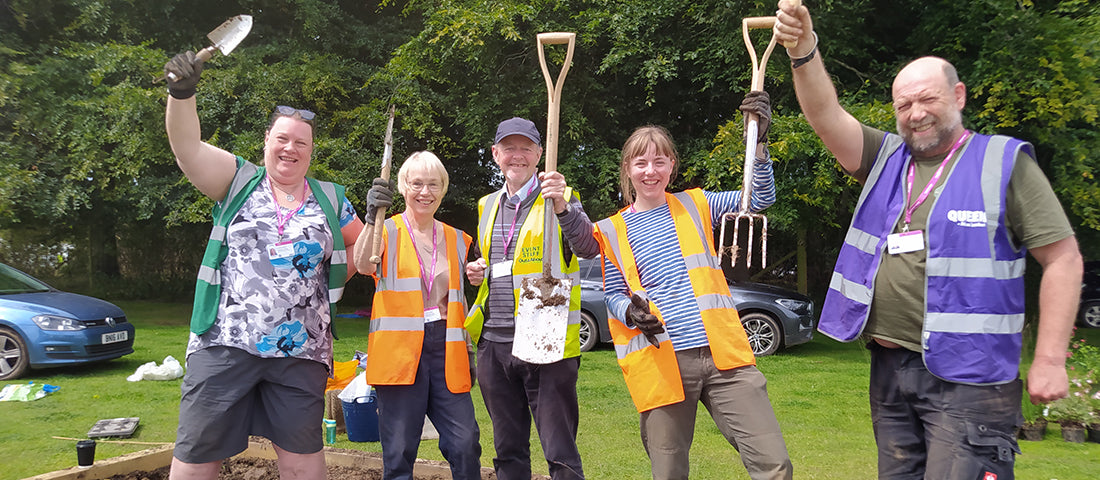
Getting started as a garden designer is tough. We like to lend a helping hand where we can, and several times we’ve supported young designers entering the Long Border awards at RHS Tatton Park. For the show this year we’ve been delighted to work with Sarah Rose Collings, whose design highlighted ‘Plants That Sense Us’.
Read on for Sarah’s take on what it’s like to find yourself building your first RHS show garden.
o0o
During the long process of designing, building, exhibiting and dismantling my first show garden at RHS Flower Show Tatton Park, one question kept popping into my head: “How did I get myself into this?”
That question popped up in April, when I was scouring allotments across Sheffield for spare plant pots to transplant hundreds of seedlings. It happened on my first day at Tatton Park, standing under a shaky marquee in 40mph winds, watching my delicate plants get blown to bits. And it happened when I was standing with Frances Tophill and the BBC Gardeners’ World team, trying to get my exploding cucumber plants to explode on camera for the Friday night programme.

There are two answers to that question. The first is naivety. I didn’t know about the long days, early mornings, physical and mental work, hundreds of plants and tens of thousands of visitors. I didn’t know how much designers were personally responsible for, from getting their own tools and equipment on-site, to managing the health and safety of volunteers. I definitely didn’t know how much nursery-grown plants cost for show gardens. If I had known any of that, I would never have had the confidence to get involved in the first place!
The second answer is community; drawing on the support network that I had not realised existed around me.
One thing that has been drilled into me during my MA Landscape Architecture course in Sheffield is that plants grow in communities. They do best when they are among the right neighbours - the reasons for which scientists are only just beginning to understand. It is one way in which humans are like plants, and it was my community that helped me achieve my goal of exhibiting at the RHS show.
My long border design was called “Plants That Sense: a Living Laboratory”. It celebrated how plants use their senses to react to the world around them. Every plant I used had some kind of notable reaction to external stimuli:
• sunflowers turning in the sun,
• hydrangeas changing colour in the soil,
• Exploding cucumbers responding to touch,
• and evening primrose plants sweetening their nectar in response to the sound of pollinators.

Caption: Sarah's design showcased plants that react to stimuli in their environment. It featured plant supports crafted from recycled scrap metal

I submitted my design for Tatton Park in January. When I got my acceptance email in March, I quickly realised I didn't know where to start, and needed help.
Asking for help is intimidating, but the truth is that gardeners love to share. Help came in various shapes and sizes. For example, one week before the show, I found out the evening primrose plants I had ordered were no longer available. Unable to find any alternative suppliers, I started to reach out on social media and to people I knew. I didn’t realise how supportive the community of gardeners in Sheffield would be. Imagine my surprise when I attended an event at the Friends of Botanical Gardens Sheffield, and the chair stood up and said “a student in Sheffield is looking for evening primrose plants.” I had to put up my hand and say, that student is me!
I ended up going to Tatton Park with evening primrose plants donated by my neighbour, my friend’s mum and total strangers. At the show, my friends and family came along to help build the garden. In addition, the garden was made financially possible due to sponsorship (and encouragement!) from Burgon and Ball, Yorkshire Gardens Trust and the University of Sheffield. Working in a team made it a much more enjoyable experience, as did the opportunity to meet other designers at the show and see their creations come to life.


Once my garden was finished, I was totally in love with it. I was so proud to show it to the visitors, talk them through the plants, and even have it filmed for the BBC. Dismantling the garden at the end of the show felt quite sad. However, having benefited from the support of the community to build the garden, I was delighted to donate all the tools, plants and structures to Gatis Community Space, a grassroots project in my hometown of Wolverhampton. It can now be visited (for free) at the volunteer-led garden in Wolverhampton.
While at times I couldn’t believe I had got myself into such a challenging experience, the chance to collaborate with other gardeners and bring a design to life was a real privilege. I can’t wait to create more projects that involve people in gardening and celebrate the beauty of plants.
o0o
Sarah Rose Collings is a gardener, designer and Landscape Architecture student based in Sheffield, UK. Her interests include using gardening and green spaces as a tool to address social inequity. Sarah Rose trained at the Valencian Municipal School of Landscaping (Spain), and is currently completing an MA in Landscape Architecture at the University of Sheffield. You can follow her experiences as a gardener and student of landscape on her Instagram account.
Many thanks to Sarah for sharing her experience of creating a first show garden with us, and congratulations on achieving an RHS bronze medal.
Caption to main header image: Volunteers from Gatis Community Space helped move the plants to their permanent home in Wolverhampton.

